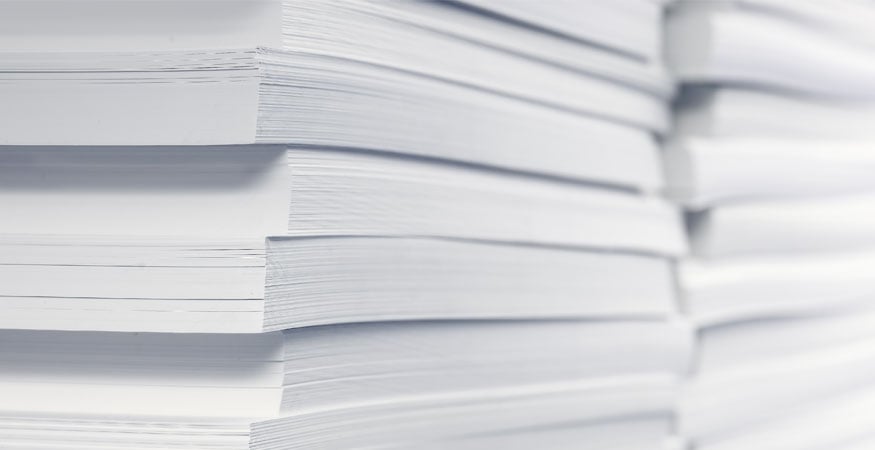Paper jam. Two of the most dreaded words when you need to print a document. Especially if you are in a hurry and on your way to a meeting.
There are several factors about the paper you are using in your copier or printer that could potentially cause a problem. Considering these things before you click that “print” button could save you both time and trouble.
Before your next printing project, be sure to keep these paper characteristics in mind to ensure maximum success.
- Paper Age
- Paper Temperature
- Moisture Content
- Paper Curl and Fanning the Paper
- Paper Grain
- Recycled Content Paper
Paper Age
It’s a great idea to keep a sufficient supply of printer paper on hand. After all, you don’t want to run out of paper during a big printing project. And keeping a few extra reams of paper nearby your printer will allow for quick replenishment when your printer runs out of paper.
While purchasing paper in large quantities can be cost effective, experts recommend keeping only a three-month supply on hand. Office copying/printing paper may last longer – possibly up to three years. But the three month rule ensures better quality paper and limited need for taking up valuable storage space.
Also, if you find some paper hidden away that looks discolored, do not use it – recycle it! This visual cue is a simple reminder to check the age of your paper stock and turn it over, frequently.
RELATED ARTICLE: How Different Weights of Printer Paper Impact Your Printer and Project
Paper Temperature
Many office administrators are unaware that the temperature of their paper may affect the quality of their printing. For instance, if your paper is stored in a room that is too cold, you may find the paper looking wavy as you unwrap a ream. We recommend that paper sit at room temperature for at least 24 hours before use. If paper is too cold (or too warm) due to shipping and outdoor temperatures, it could also increase your chances of a paper jam or toner/ink coverage concerns.
RELATED ARTICLE: Printer Paper Sizes Explained in Plain Language
Moisture Content
The relative humidity of the environment where your paper is being stored can also be a factor. It is recommended to store your copy/printer paper in an area that has a controlled relative humidity of 35 to 55%. Less than this could dry out the paper fibers, causing static electricity that can promote paper jams and misfeeds in your printer.
An open ream of paper can also absorb more humidity from the air, than a sealed ream. Therefore, always refill your empty paper tray with paper from an open ream first (if available), before opening a new ream of paper. This will limit the amount of time an open ream sits out before use and mitigates the chance of printer trouble due to high moisture content in your paper.
RELATED ARTICLE: How to Know Which Printer Paper Stock to Use
Paper Curl and Fanning the Paper
High moisture content can also cause your paper to curl, wrinkle as it goes through the printer or create misfeeds. If paper curl is a concern within your office environment, consider flattening the paper reams under a large book or two for weight or flipping the carton of paper reams upside down, while in storage.
Also be sure to fan the ream of paper before placing in the paper tray. You can do this by holding the ream of paper in one hand and flipping through the pages with the other hand. Fanning the paper helps to loosen the pages in the stack after storage.
Paper Grain
Most copier/printer paper has long grain paper fibers. Therefore, the grain runs along the longer side of your sheet of paper. However, short grain paper is also available, in which the paper fibers are perpendicular to the long edge of the paper.
While paper grain can affect print quality, it is also very important to consider if you will be using a finishing unit at the end of your machine to fold, score or bind your document. Folding parallel to the grain will create a smoother, neater crease. Folding against the grain will cause the paper fibers to break and form a less even crease.
Recycled Content Paper
Even today, many users still believe that recycled paper can cause paper jams. This myth was debunked in 1998 when several major printer manufacturers (including Canon and Lexmark) along with the U.S. Government Printing Office tested over two million sheets of recycled paper on various models of copiers and printers. The results indicated that multi-purpose recycled content paper containing 30% postconsumer fiber works just fine in office equipment.
Working with a Managed Print Services Provider
Relying on the expertise of a Managed Print Services provider, like Gordon Flesch Company, can assist you in streamlining your print fleet. And we’re got the tips and tricks to share with you to make sure your printing and copying projects run smoothly.
Click on the link below to download your free Checklist of Office Printers. This print audit checklist will help to identify vulnerabilities in your print environment and find room for improvement.










